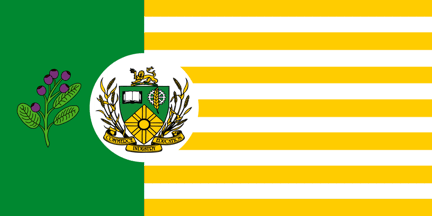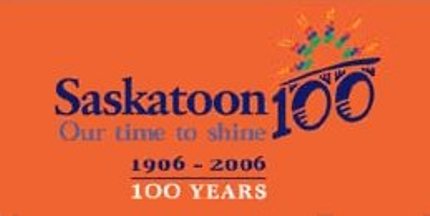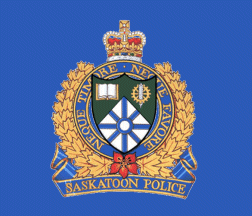 1:2 image by Eugene Ipavec
1:2 image by Eugene IpavecSource: Canadian City Flags, Raven 18

Last modified: 2020-06-13 by rob raeside
Keywords: saskatchewan | saskatoon | saskatoon berries | book |
Links: FOTW homepage |
search |
disclaimer and copyright |
write us |
mirrors
 1:2 image by Eugene Ipavec
1:2 image by Eugene Ipavec
Source: Canadian City Flags,
Raven 18
See also:
In 1882, the Toronto-based Temperance Colonization Society was granted 21
sections of land straddling the South Saskatchewan River, between what is now
Warman and Dundurn. The aim of the group was to escape the liquor trade in that
city and set up a "dry" community in the Prairie region. The following year
settlers, led by John Neilson Lake, arrived on the site of what is now Saskatoon
and established the first permanent settlement. The settlers travelled by
railway from Ontario to Moose Jaw and then completed the final leg via
horse-drawn cart as the railway had yet to be completed to Saskatoon.
In
1885 the Northwest Rebellion affected the tiny community in a variety of ways.
Chief Whitecap and Charles Trottier passed through the present day University
campus on their way to join Louis Riel's armed forces at Batoche, Saskatchewan.
Following the fighting at the Battle of Fish Creek, and the Battle of Batoche,
wounded Canadian soldiers convalesced at the Marr Residence which is today a
historic site. A few died in care and were buried in the Pioneer Cemetery near
the Exhibition Grounds.
A town charter for the west side of the river was
obtained in 1903 (Nutana became a village in that year). On May 26th 1906
Saskatoon became a city with a population of 4,500, which included the
communities of Saskatoon, Riversdale and Nutana. In 1955 Montgomery Place and in
1956 the neighboring town of Sutherland were annexed by the fast-growing City of
Saskatoon.
Neal Wilson, 9 July 2016
Text and image(s) from Canadian City Flags, Raven 18 (2011), courtesy of the North American Vexillological Association, which retains copyright. Image(s) by permission of Eugene Ipavec.
The flag of the City of Saskatoon is divided vertically into green
at the hoist (one-third the flag’s length) and thirteen alternating yellow and
white horizontal stripes at the fly (two-thirds the flag’s length). In the centre
of the green section is a sprig of saskatoon berries, purple with light green leaves and
stem. Centred at the divide is a white disc, half the height of the flag, containing
the city’s coat of arms. The simple shield has a horizontal top and
simply-curved sides forming a pointed “U” shape. It contains two sections,
the upper in green, the lower in the shape of a diamond in yellow (some versions
show it in white). The upper section has, on the left, an open book in
white with black details, and on the right, a wheat stalk in yellow surmounting
a cogged wheel of six spokes in white, both with black details. The lower
section has at its centre a black circle from which eight pairs of lines extend
to the edges of the diamond. Above the shield is a lion in yellow with black
details, oriented to the left and looking outward, holding a sprig of saskatoons,
above a torse of yellow and green. Stalks of wheat in yellow, with three stems
and four heads, wrap around either side of the shield. Below is a yellow ribbon
in three sections, inscribed COMMERCE INDUSTRY EDUCATION in
black serif letters; the central word is sometimes larger.
Alison Wilkes, Canadian City Flags,
Raven 18,
2011
Green and gold are the city’s official colours and represent
the importance of agriculture; green for growing crops and gold for the harvest.
The seven yellow stripes stand for the city’s seven districts: North Park,
City Park, Pleasant Hill, Mayfair, Caswell Hill, City Centre, and Nutana.
The name “Saskatoon” comes from the Saskatoon berry (Amelanchier alnifolia),
ever-present in the prairies and shown on the hoist of the flag and in the
lion’s paw. The open book of learning comes from the shield of the University
of Saskatchewan, and marks the connection between the academic seat and
the city. The cogged wheel and wheat stalk represent the agricultural industry.
The parallel lines extending from the central circle show the importance
of Saskatoon, “The Hub City”, as a railway and distribution centre. The central
circle is a coin (or “bezant” in heraldry) which signifies the commercial
importance of the city. The lion in the crest comes from Saskatchewan’s arms.
Alison Wilkes, Canadian City Flags,
Raven 18,
2011
Descombe “Deck” Whitehead and Henry Mirtle, apparently. (Professor A.L.C. Atkinson, an engineering professor at the University of Saskatchewan, designed the coat of arms).
The selected flag was said to be the work of artist
Descombe “Deck” Whitehead and sign painter Henry Mirtle; Whitehead
designed it and Mirtle painted it to scale on a piece of wallboard. Apparently
the painted flag was then discovered in a city transit garage by the city utilities
manager, who liked it, and when offered the flag by Mirtle brought it back
to City Hall, where it was displayed in the office of a city commissioner and
eventually adopted as Saskatoon’s flag. On some versions of the flag, CITY
of SASKATOON appears below the disc in sans-serif letters.
Alison Wilkes, Canadian City Flags,
Raven 18,
2011
During the year 1948, the question of the City’s Coat of Arms was brought to
the attention of the City Council. It was pointed out that the design which had
been in use since being adopted by Council on January 30, 1913 was incapable of
being described in proper heraldic language and therefore could not be formally
adopted by bylaw. It was considered advisable that the City’s Coat of Arms be
properly adopted and approved and Professor A.L.C. Atkinson was requested to
design a new Coat of Arms and Crest. This was adopted by Bylaw No. 3081 and
approved by Order-In-Council N110.49 dated January 14th , 1949.
The
heraldic description of “Blazon” is:
Arms – Per chevron vert and or,
in dexter chief an open book of learning argent leathered sable, in sinister
chief a cogged wheel of six spokes in saltire and less of the third overall a
wheat ear of the second, in a base a cross and saltire voided of the least with
overall an annulet of the last encircling a bezant.
Crest - On a wreath
of the colors a lion passant guardant or holding in his dexter paw a sprig of
Saskatoon berries.
Motto – On a scroll are the words “Commerce Industry
Education”
Note – The decoration flanking the shield is purely
ornamental and is not mentioned in any blazoning. It is included (or omitted)
both in particulars and in design according to the taste of the artist.
Symbolism –
1) The background of the shield is divided into two parts, the
upper being green and the lower gold. This suggests the main agricultural
background of Saskatoon; the green of growing crops, the gold of harvest.
2)
The silver open book of learning bound in black leather, on a green field, is
taken directly from the Arms of the University of Saskatchewan and marks the
connection between the academic seat and the city.
3) The silver cogged
wheel with golden wheat war superimposed is significant of industry
predominantly connected with agriculture.
4) The eight sets of paralleled
lines on the gold background, radiating from a hub are symbolic of the
importance of Saskatoon as a railway and distribution center. The golden coin
encircled by the hub is indicative of the commercial importance of the city.
Two clipped articles from the Saskatoon Star-Phoenix, likely from 1976,
document the flag design. The first clipping in addition shows a green pennant, bearing the arms
on a white disk toward the hoist and the spray of Saskatoon berries on the
remainder of the pennant. The second clipping
documents the discovery of the original flag, made by Dick Whitehead and
approved by council in 1952, attached to a wall in a transit garage.
Neal Wilson, 9 July 2016
 image by Darrell Neuman, 13 May 2006
image by Darrell Neuman, 13 May 2006
 image by Randy Young, 31 October 2015
image by Randy Young, 31 October 2015
Formed in 1903, the Saskatoon Police Service is a Canadian law enforcement
agency with both municipal and provincial jurisdiction, based in the city of
Saskatoon, Saskatchewan. The SPS operations in cooperation with the Royal
Canadian Mounted Police. In addition to law enforcement duties at home, members
of the SPS have deployed worldwide to help train law enforcement officers in
developing countries, such as Afghanistan and Kosovo.
The armorial
bearings and flag of the Saskatoon Police Service were recorded in the Canadian
Register of Arms in June 2007. Information regarding the flag can be found at
http://reg.gg.ca/heraldry/pub-reg/project-pic.asp?lang=e&ProjectID=1169&ProjectElementID=4116.
The flag is light blue with the SPS badge (as recorded in the Register) centered
on the field. The flag is sometimes displayed with an alternating fringe of blue
and gold.
Randy Young, 31 October 2015